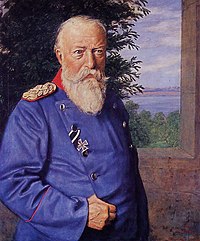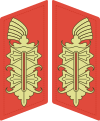Generaloberst

A Generaloberst ("
A literal translation of Generaloberst would be "uppermost general", but it is often translated as "colonel-general" by analogy to Oberst, "colonel", such as in countries in which the rank was adopted like Russia (Russian: генерал-полковник, general-polkovnik). "Oberst" derives from the superlative form of Germanic ober (upper), cognate to English over and so "superior general" might be a more idiomatic rendering.
The rank was created in 1854, originally for
Since the rank of Generalfeldmarschall was reserved for wartime promotions, the additional distinction of a "Colonel general with the rank of field marshal" (Generaloberst im Range eines Generalfeldmarschalls) was created. Such generals were entitled to wear three pips and a marshal's crossed batons on their shoulder boards, compared to the three pips of a Colonel General; however, this was changed to four pips in 1911.[1]
Generaloberst was the second-highest general officer rank, below
Austro-Hungarian Army

In 1915 the Generaloberst – Vezérezredes rank was introduced to the
- See also
- Erzherzog Joseph Ferdinand von Österreich-Toskana (1872–1942)
- Friedrich Graf von Beck-Rzikowsky (1830–1920)
- Eduard Graf Paar (1837–1919)
- Arthur Freiherr von Bolfras (1838–1922)
- Friedrich Freiherr von Georgi (1852–1926)
- Karl Freiherr von Pflanzer-Baltin (1855–1925)
- Viktor Graf Dankl von Krasnik (1854–1941)
- Karl Tersztyánszky von Nádas (1854–1921)
- Adolf von Rhemen (1855–1932)
- Paul Freiherr Puhallo von Brlog (1856–1926)
- Erzherzog Leopold Salvator von Österreich-Toskana (1863–1931)
- Karl Graf von Kirchbach auf Lauterbach(1856–1939)
- Karl Georg Graf Huyn (1857–1938)
- Hermann Kusmanek von Burgneustädten (1860–1934)
- Karl Křitek (1861–1928)
- Wenzel Freiherr von Wurm (1859–1921)
- Samuel Freiherr von Hazai (1851–1942)
- Leopold Freiherr von Hauer (1854–1933)
- Viktor Graf von Scheuchenstuel(1857–1938)
- Stephan Freiherr Sarkotić von Lovčen (1858–1939)
- Josef Freiherr Roth von Limanowa-Łapanów (1859–1927)
- Arthur Freiherr Arz von Straußenburg (1857–1935)
- Hugo Martiny von Malastów (1860–1940)
- Rudolf Freiherr Stöger-Steiner von Steinstätten (1861–1921)
- Alois Fürst Schönburg-Hartenstein (1858–1944)
German Empire
Rank insignia of the


Bavarian Army
- December 27, 1911 – Minister of War
- August 1, 1914 – Otto Kreß von Kressenstein (1850–1929), Minister of War
- April 9, 1918 – Felix von Bothmer(1852–1937), commander-in chief in WW I
Prussian Army

- March 20, 1854 – Wilhelm of Preußen (1797–1888), with the special rank of Generalfeldmarschall
- June 16, 1871 – Albrecht of Preußen (1809–1872), with the special rank of Generalfeldmarschall
- September 2, 1873 – August Prinz von Württemberg (1813–1885), Commander and Governor of Berlin
- June 25, 1888 – Frederick I, Grand Duke of Baden (1826–1907), with the special rank of Generalfeldmarschall, Inspector of the Army
- September 19, 1888 – Alexander August Wilhelm von Pape (1813–1895), with the special rank of Generalfeldmarschall, Commander in den Marken and Governor of Berlin
- December 21, 1889 – Charles Alexander, Grand Duke of Saxe-Weimar-Eisenach (1818–1901)
- March 20, 1890 – Otto von Bismarck (1815–1898), with the special rank of Generalfeldmarschall à la suite of the Army, 1st Chancellor of Germany
- October 18, 1901 – Leopold, Prince of Hohenzollern (1835–1905)
- March 22, 1902 – Adolphe, Grand Duke of Luxembourg (1817–1905)
- September 15, 1905 – Bernhard III, Duke of Saxe-Meiningen (1851–1928), with the special rank of Generalfeldmarschall, Inspector of the Army
- September 15, 1905 – Frederick II, Grand Duke of Baden (1857–1928), with the special rank of Generalfeldmarschall, Inspector of the Army
- September 13, 1906 – Ernst Rudolf Max Edler von der Planitz (1836–1910), Inspector General of the Cavalry
- September 28, 1907 – Ernst I, Duke of Saxe-Altenburg (1826–1908), with the special rank of Generalfeldmarschall of the Prussian Army[2]
- September 18, 1908 – Hans von Plessen (1841–1929), with the special rank of Generalfeldmarschall, Adjutant General of the Kaiser and Commander of the Großes Hauptquartier ("Great Headquarters")
- 4. September 4, 1909 – Großadmiral, Inspector general of the Navy, à la suite of the Prussian Army
- September 10, 1910 – Prince Friedrich Leopold of Prussia (1865–1931), à la suite
- January 22, 1911 – Prince Christian of Schleswig-Holstein (1831–1917), à la suite
- January 27, 1911 – Gustav von Kessel (1846–1918), Adjutant General of the Kaiser, Commander in the Marken, and Governor of Berlin
- September 13, 1912 – Karl von Bülow (1846-1921), Army Commander, promoted to Generalfeldmarschal in 1915
- January 1, 1913 – Hermann von Eichhorn (1948-1918) Army Group Commander, promoted to Generalfeldmarschal in 1917
- June 16, 1913 – Maximilian von Prittwitz (1848–1917), Army Commander
- June 16, 1913 – Friedrich von Scholl (1846–1928), Adjutant General of the Kaiser
- January 27, 1914 – Josias von Heeringen (1850–1926), Army Commander
- January 27, 1914 – Helmuth von Moltke the Younger (1848–1916), Chief of the 1st Oberste Heeresleitung
- January 27, 1914 – Alexander von Kluck (1846–1934), Army Commander
- December 3, 1914 – August von Mackensen (1849-1945), Army Commander, promoted to Generalfeldmarschal in 1915
- December 3, 1914 – Remus von Woyrsch (1847-1920), Army Group Commander, promoted to Generalfeldmarschal in 1917
- December 24, 1914 – Moritz von Bissing (1844–1917), Governor general of Belgium
- December 24, 1914 – Ludwig von Falkenhausen (1844–1936), Army Commander
- January 27, 1915 – Karl von Einem (1853–1934), Army Commander
- February 20, 1916 – Alexander von Linsingen (1850–1935), Army Commander
- January 27, 1917 – Günther Graf von Kirchbach (1850–1925), Commander of Heeresgruppe Kiew
- January 27, 1917 – Richard von Schubert (1850–1933), Army Commander
- January 27, 1918 – Hans von Beseler(1850–1921), Army Commander
- March 22, 1918 – Max von Boehn(1850–1921), Army Group Commander
- April 10, 1918 – Moriz Freiherr von Lyncker (1853–1932), Chief of the Military Cabinet
Royal Saxon Army
- December 21, 1889 – Carl Alexander Großherzog of Sachsen (1818–1901)
- September 15, 1905 – Bernhard Erbprinz of Sachsen-Meiningen (1851–1928)
- September 28, 1907 – Ernst I, Duke of Saxe-Altenburg (1826–1908)
- September 4, 1909 – Prince Henry of Prussia (1862–1929)
- December 17, 1910 – Max Freiherr of Hausen (1846–1922), Minister-President, Army Commander
- January 23, 1918 – Karl Ludwig d'Elsa (1849–1922), Army Commander
- January 23, 1918 – Hans von Kirchbach (1849–1928), Army Commander
Army of Württemberg
- February 25, 1913 – Philipp Herzog von Württemberg(1838–1917), à la suite of the Army of Württemberg
- September 24, 1913 – Albrecht Herzog von Württemberg(1865–1939), later also Prussian Generalfeldmarschall
- February 25, 1918 – Otto von Marchtaler (1854–1920), Minister of War
Weimar Republic
Reichswehr
- January 1, 1926 – Hans von Seeckt (1866–1936), Chief of the Heeresleitung
- January 1, 1930 – Wilhelm Heye (1869–1947), Chief of the Heeresleitung
- 1934 – Kurt Freiherr von Hammerstein-Equord(1878–1943), Chief der Heeresleitung
Nazi Germany
Wehrmacht
| Colonel General Generaloberst | |
|---|---|
 | |
 Army shoulder board and flecktarn suit insignia | |
| Country | |
| Service branch | |
| Formation | 20 April 1936 |
| Abolished | 1945 |
| Next higher rank | Generalfeldmarschall |
| Next lower rank | General der Waffengattung |
| Equivalent ranks | See list |
The equivalent ranks of a colonel general were in the:
- Generaladmiral
- Waffen-SS – SS-Oberst-Gruppenführer und Generaloberst der Waffen-SS
- Oberst-Gruppenführer
- Sturmabteilung (SA) – No equivalent
- Ordnungspolizei (Orpo) – Generaloberst der Polizei ("Colonel general of police")
Heer
- August 31, 1933 – Werner von Blomberg (1878–1946)
- January 1, 1934 – Kurt Freiherr von Hammerstein-Equord(1878–1943)
- April 20, 1936 – Werner Freiherr von Fritsch(1880–1939)
- February 1, 1938 – Walther von Brauchitsch (1881–1948)
- March 1, 1938 – Gerd von Rundstedt (1875–1953)
- March 1, 1938 – Wilhelm Ritter von Leeb (1876–1956)
- March 1, 1938 – Fedor von Bock (1880–1945)
- November 1, 1938 – Ludwig Beck (1880–1944)
- November 1, 1938 – Wilhelm Keitel (1882–1946)
- January 1, 1939 – Wilhelm Adam (general) (1877–1949)
- April 1, 1939 – Wilhelm List (1880–1971)
- October 1, 1939 – Günther von Kluge (1882–1944)
- October 1, 1939 – Johannes Blaskowitz (1883–1948)
- October 1, 1939 – Walter von Reichenau (1884–1942)
- November 1, 1939 – Erwin von Witzleben (1881–1944)
- July 19, 1940 – Franz Halder (1884–1972)
- July 19, 1940 – Friedrich Dollmann (1882–1944)
- July 19, 1940 – Ewald von Kleist (1881–1954)
- July 19, 1940 – Maximilian von Weichs (1881–1954)
- July 19, 1940 – Georg von Küchler (1881–1968)
- July 19, 1940 – Eugen von Schobert(1883–1941)
- July 19, 1940 – Erich Hoepner (1886–1944)
- July 19, 1940 – Heinz Guderian (1888–1954)
- July 19, 1940 – Hermann Hoth (1885–1971)
- July 19, 1940 – Adolf Strauß (1879–1973)
- July 19, 1940 – Ernst Busch (1885–1945)
- July 19, 1940 – Nikolaus von Falkenhorst (1885–1968)
- July 19, 1940 – Curt Haase (1881–1943)
- July 19, 1940 – Friedrich Fromm (1888–1945)
- July 19, 1940 – Eugen Ritter von Schobert(1883–1941)
- January 1, 1942 – Rudolf Schmidt (1886–1957)
- January 1, 1942 – Georg-Hans Reinhardt (1887–1963)
- December 3, 1942 – Hans-Jürgen von Arnim (1889–1962)
- January 1, 1943 – Gotthard Heinrici (1886–1971)
- January 1, 1943 – Hans von Salmuth (1888–1962)
- January 30, 1943 – Walter Heitz (1878–1944)
- March 6, 1943 – Karl Strecker (1884–1973)
- July 6, 1943 – Eberhard von Mackensen (1889–1969)
- September 1, 1943 – Heinrich von Vietinghoff-Scheel (1887–1952)
- September 1, 1943 – Karl-Adolf Hollidt (1891–1985)
- February 1, 1944 – Alfred Jodl (1890–1946)
- February 1, 1944 – Erwin Jaenecke (1890–1960)
- February 1, 1944 – Walter Weiß (1890–1967)
- February 1, 1944 – Kurt Zeitzler (1895–1963)
- April 1, 1944 – Josef Harpe (1887–1968)
- April 1, 1944 – Lothar Rendulic (1887–1971)
- April 20, 1944 – Hans-Valentin Hube (1890–1944)
- July 23, 1944 – Johannes Frießner (1892–1971)
- August 15, 1944 – Erhard Raus (1889–1956)
- May 1, 1945 – Carl Hilpert (1888–1947)
Luftwaffe
- April 20, 1936 – Hermann Göring (1893–1946)
- November 1, 1938 – Erhard Milch (1892–1972)
- July 19, 1940 – Ulrich Grauert (1889–1941)
- July 19, 1940 – Hans-Jürgen Stumpff (1889–1968)
- July 19, 1940 – Ernst Udet (1896–1941)
- July 19, 1940 – Hubert Weise (1885–1944)
- July 19, 1940 – Alfred Keller (1882–1974)
- May 3, 1941 – Alexander Löhr (1885–1947)
- February 1, 1942 – Wolfram Freiherr von Richthofen(1895–1945)
- April 1, 1942 – Hans Jeschonnek (1899–1943)
- November 1, 1942 – Günther Rüdel (1883–1950)
- February 16, 1943 – Bruno Loerzer (1891–1960)
- February 16, 1943 – Robert Ritter von Greim (1892–1945)
- March 1, 1944 – Otto Deßloch (1889–1952)
- July 13, 1944 – Kurt Student (1890–1978)
- July 22, 1944 (Posthumous) – Günther Korten (1909–1944)
Waffen-SS
SS-Oberst-Gruppenführer and Generaloberst of the Waffen-SS:
- 1942 – Sepp Dietrich (1892–1966)
- 1944 – Paul Hausser (1880–1972)
German Police
SS-Oberst-Gruppenführer and Generaloberst of the Police:
- 1942 – Kurt Daluege (1897–1946)
German Democratic Republic (East Germany)
National People's Army
In the
- See also
- Ranks of the National People's Army
| Preceded by Junior rank Generalleutnant |
(NPA rank) Generaloberst |
Succeeded by Senior rank Armeegeneral |
- March 1, 1966 Kurt Wagner(1904–1989)
- March 1, 1972 Herbert Scheibe (1914–1991)
- March 1, 1976 Horst Stechbarth (1925–2016)
- October 7, 1977 Werner Fleißner (1922–1985)
- July 14, 1979 Erich Peter (1919–1987)
- October 7, 1979 Wolfgang Reinhold (1923–2012)
- October 7, 1979 Fritz Streletz (born 1926)
- March 1, 1986 Joachim Goldbach (1929–2008)
- March 1, 1987 Horst Brünner (1929–2008)
- October 7, 1988 Klaus-Dieter Baumgarten (1931–2008)
- October 7, 1989 Fritz Peter (born 1927)
Ministry of State Security
- February 1980 Bruno Beater (1914–1982)
- May 1986 Markus Wolf (1923–2006)
- February 1987 Rudi Mittig (1925–1994)
- 1989 Werner Großmann(1929-2022)
Deutsche Volkspolizei (DVP)
- 1962 Karl Maron (1903–1975)
- 1987 Karl-Heinz Wagner (1928–2011)
See also
- Colonel general
- List of German colonel generals
- Comparative military ranks of World War I
- Comparative military ranks of World War II
- Ranks of the National People's Army
References
- ISBN 9783486817683.
- ^ Kurt von Priesdorff. Soldatisches Führertum. Vol. 6, Hamburg: Hanseatische Verlagsanstalt, n. d., p. 417.





